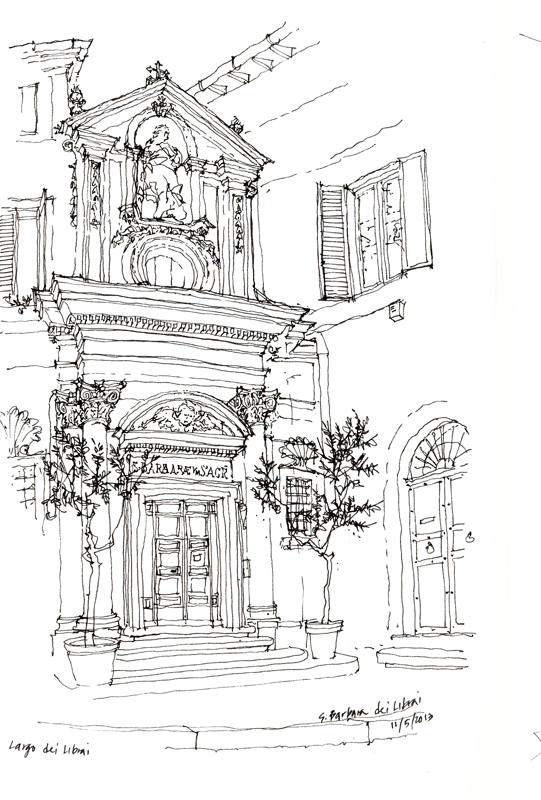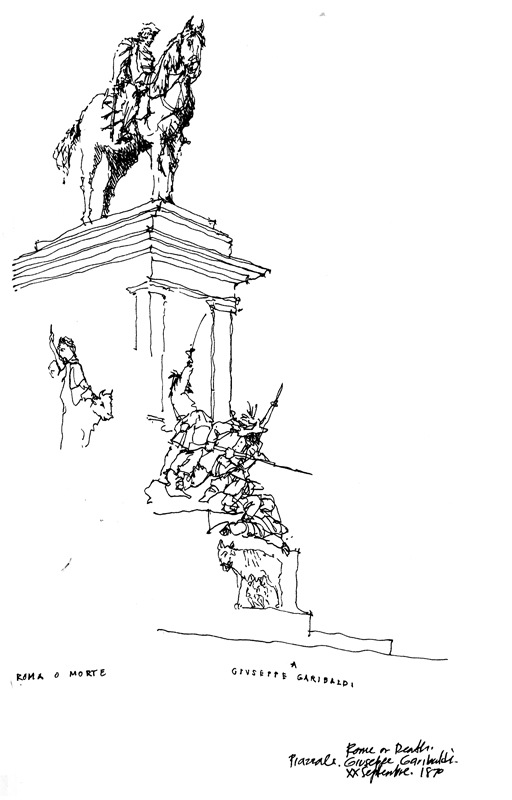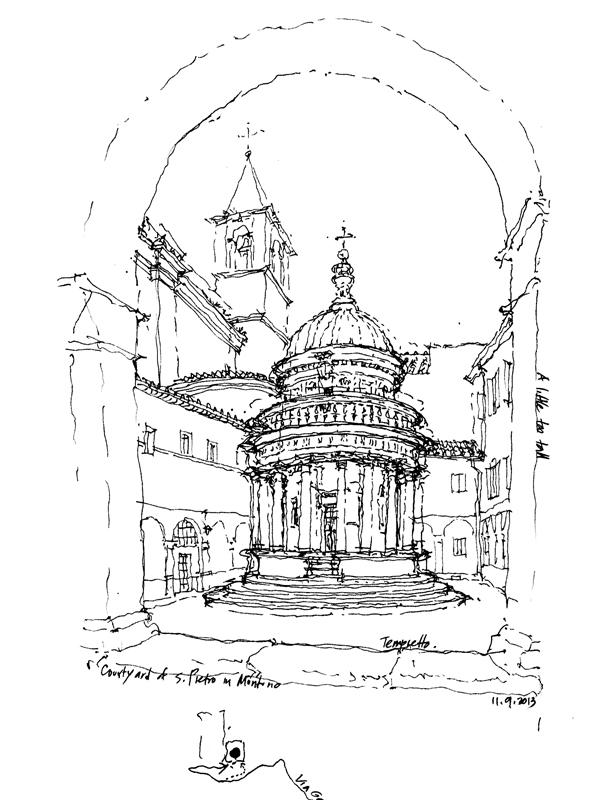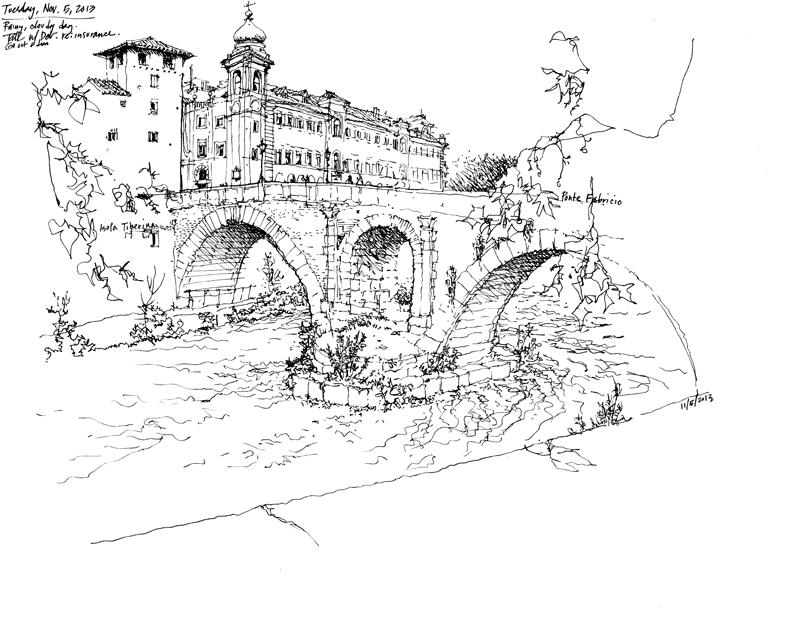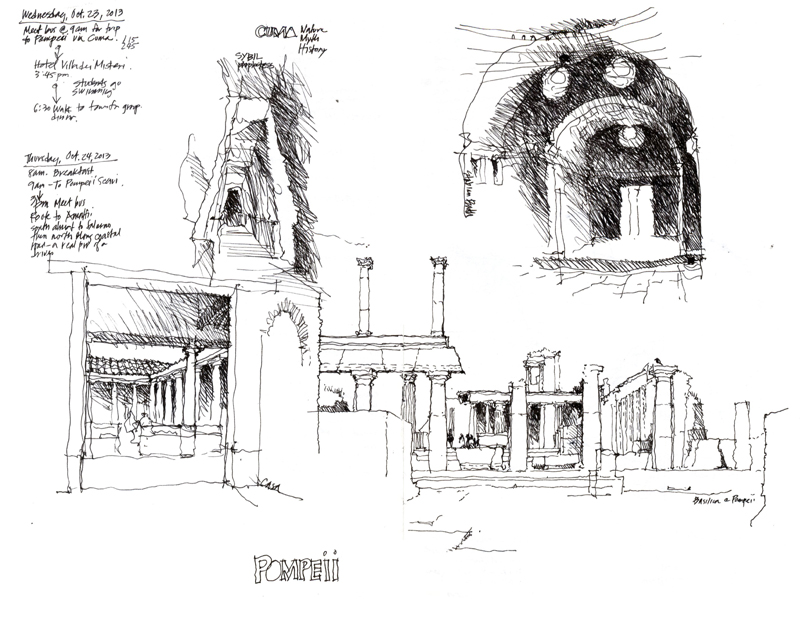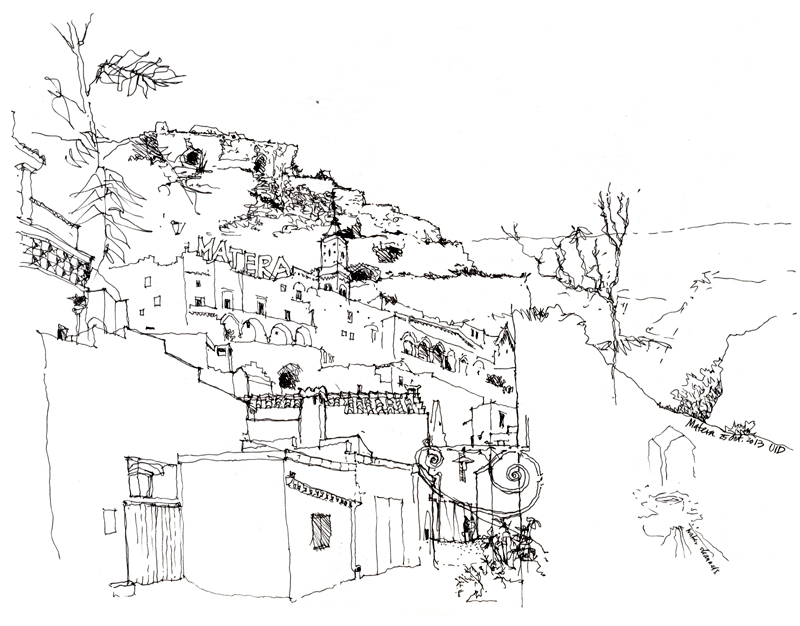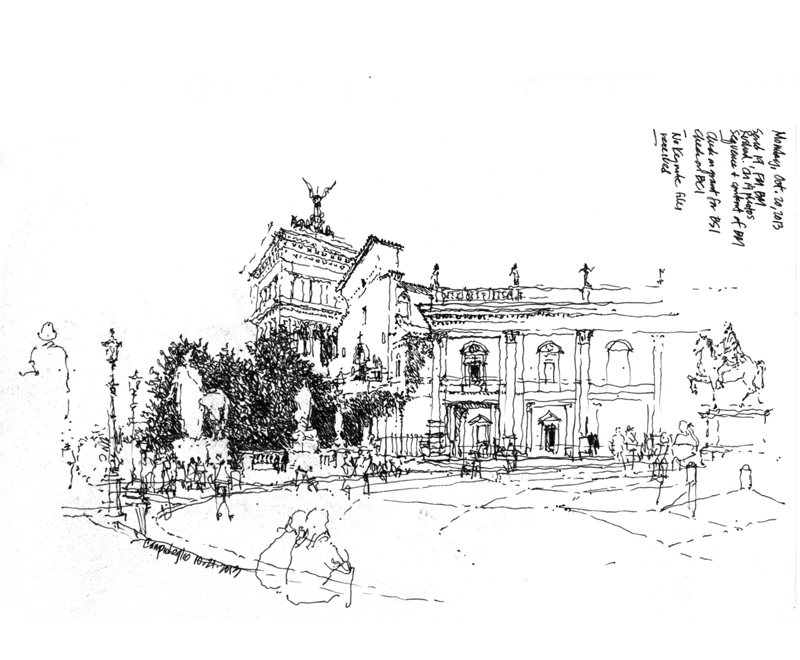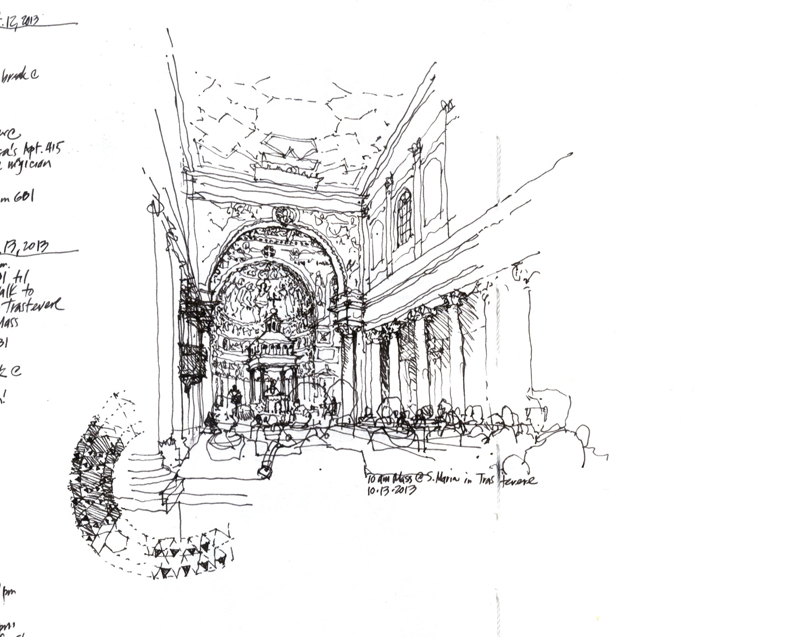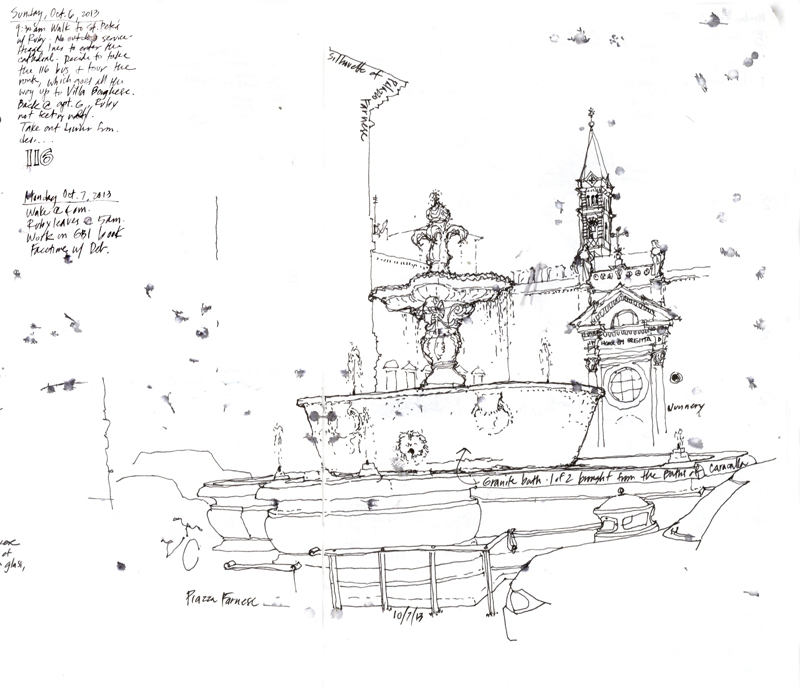Tucked away at the end of Largo dei Librari just off of Via Giubbonari is this tiny church, hemmed in by taller buildings on both sides. Like much of the area, it’s foundations were constructed over the ruins of the Theatre of Pompey sometime in the 11th century. This church was rebuilt in the Baroque style in 1680, and restored in 1858.
Category Archives: Drawing
Giuseppe Garibaldi
Atop the Janiculum Hill (Gianicolo) stands this monument to Giuseppe Garibaldi, one of Italy’s “fathrers of the fatherland.”
It is interesting to note that Italy as we know it was not a unified country until the 19th century. From the end of the Holy Roman Empire, it had been a shifting collection of city-states and kingdoms. The Italian unification (Risorgimento) movement was a long process in the 19th century that ended with the capture of Rome on 20 September (XX Septembre) 1870 by the Italian army under the command of General Raffaele Cadorna, who breached the Aurelian Wall at Porta Pia.
While Garibaldi was not present during the capture of Rome, he was a central figure in many military campaigns that eventually led to the formation of a unified Italy. On the monument are the words: Roma o Morte (Rome or Death).
The Tempietto
Standing in the courtyard of San Pietro in Montorio on the Janiculum Hill sits this almost ideal example of Italian Renaissance architecture by Donato Bramante. What makes classical architecture such as this beautifully harmonious work so difficult to draw is that any slight deviation from the intended proportions becomes very noticeable. I’ve attempted to draw the Tempietto several times and I still haven’t got it quite right, although this one comes close. It’s just a little too tall for its base.
Isola Tiberina
Isola Tiberina (Tiber Island) stands in the Tiber River, connected to Rome on both sides by bridges. This view shows the Ponte Fabricio, built in 62 BC and still in its original state as it crosses over to meet the island. Ever since the building of an ancient temple dedicated to Aesculapius, the Greek god of medicine and healing in the third century BC, the island has been known as a site offering protection from disease and illnesses. Even today, it remains the site of the Fatebenefratelli Hospital (Ospedale Fatebenefratelli).
Pompeii
On the way down to Amalfi, we stopped at Pompeii, the infamous Roman city that, along with Herculaneum, was buried under 15 to 20 feet of ash and pumice when Mt. Vesuvius erupted in 79 AD. Declared a UNESCO World Heritage Site in 1997, Pompeii reportedly receives more than 2,500,000 visitors a year. One can imagine the wear and tear the site receives with all of this traffic but it endures as a testament to how Romans lived two thousand years ago. Even after several visits, Pompeii never disappoints.
Matera
During our field trip south to Pompeii and Amalfi, we had the opportunity to visit Matera through the generosity of the Unione Italiana Disegno, who invited me and the entire UW group to their conference that was being held there.
While in Matera, we had a tour of the Sassi, a dense network of dwellings carved out of the local tufo stone and interwoven with stone alleys and stairways. Even though many of the original rock-cut spaces are hidden behind the facades and walls built from the stone removed to create the underground dwellings, we were fortunate to get a glimpse inside one of the structures to see what the original cave spaces might have looked like. The upper drawing is looking from the Sasso Barisano to some of the caves across the glavine; filling the space below is a view of the Sasso itself.
Quoting from the Comune di Matera’s website: “Looking at the structure of the Sassi we can clearly see the social and architectural evolution of mankind, from simple dugout shelters, to caves with facades, to the construction of roofs on which to create vegetable gardens; and the evolution of the social structure of a community – human interaction amongst individuals, families, dwellings, neighborhoods and churches, from rural to urban. In 1993 UNESCO declared the Sassi of Matera a world heritage site, describing it as “the most outstanding, intact example of a troglodyte settlement in the Mediterranean region, perfectly adapted to its terrain and ecosystem. The first inhabited zone dates from the Palaeolithic, while later settlements illustrate a number of significant stages in human history.”
Many thanks to Dr. Salvatore Barba of the University of Salerno and Francesco Ferraris for their gracious hospitality during our visit to Matera.
Piazza del Campidoglio
Similar to the drawing of the archway of the Portico of Octavia, this sketch compresses three layers of history in the heart of Rome—in the right foreground, the facade of the Palazzo Nuovo designed by Michelangelo in the 16th century; rising in the background, the Vittorio Emmanuele II Monument built in the early 20th century; and caught in between but the oldest, S. Maria in Aracoeli, a basilica whose origins date back to the 6th century, erected atop an ancient Roman insula. To the right stands the equestrian statue of Marcus Aurelius that is situated in the center of the trapezoidal piazza.
We’re leaving tomorrow on a week-long field trip south to Pompeii, Amalfi, Ravello, and possibly Matera, a UNESCO world heritage site. More on that later.
A View Through the Portico
Here’s a view looking through an archway of the Portico of Octavia toward the Theater of Marcellus, with just a hint of the apartments built atop of the theater in medieval times. The elements on the left are of the scaffolding supporting restoration work on the portico.
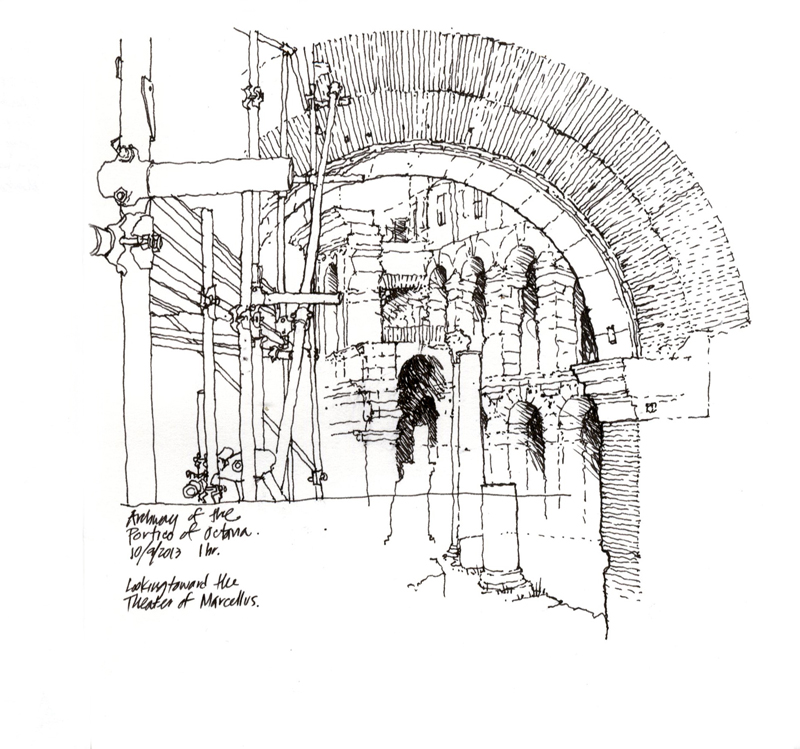 What attracted me to this scene is the way it compresses space and time. Almost everywhere you walk amid the skewed street spaces, buildings, and monuments in the centro historico district, one encounters these layers of history so typical of Rome.
What attracted me to this scene is the way it compresses space and time. Almost everywhere you walk amid the skewed street spaces, buildings, and monuments in the centro historico district, one encounters these layers of history so typical of Rome.
Santa Maria in Trastevere
This past Sunday, I attended the 10 am Mass at Santa Maria in Trastevere, a basilica that feels like a normal parish church rather than one that simply attracts tourists. Compare this view from my usual position, seated in the rear and to the left, to a similar one of Blessed Sacrament Church that I did back in mid-September.
The basilica is believed to have its origins in the 4th century, being rebuilt in the 12th century and restored several times since then. Notable are the beautiful medieval mosaics, the Cosmatesque flooring, and the 22 Ionic and Corinthian columns that line the nave, which were brought from the Baths of Caracalla and other sources.
Piazza Farnese
Early Monday morning, I walked over to Palazzo Farnese, but instead of drawing the palazzo, I chose this view of one of the huge granite tubs brought to the square from the Baths of Caracalla in the 16th century. You can see evidence of the raindrops that began falling on the pages and their imprints as I closed my sketchbook.

